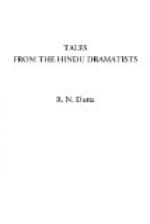It thus finally turns out that Malavika is by birth a princess, who had only come to be an attendant at Agnimitra’s court through having fallen into the hands of robbers.
The king issues his orders respecting the terms to be granted to Yajnasena, the king of Viderbha, the half of whose territory he assigns to Madhavasena, the brother of Malavika.
A letter arrives from the general Pushpamitra, giving an account of some transactions that have occurred upon the southern bank of the Indus.
On his own behalf, or that of his son, he had undertaken to celebrate an aswamedha, or horse-sacrifice, for which it was essential that the steed should have a free range for twelve months, being attended only by a guard to secure him. This guard had been placed by Pushpamitra under the command of Agnimitra’s son, Vasumitra. Whilst following the victim along the Indus, a party of Yavana horse attempted to carry off the courser, but they were encountered by the young prince, and after a sharp conflict, defeated.
Pushpamitra concludes with inviting his son to come with his family to complete the sacrifice.
The queen, Dharini, overjoyed with the news of her son’s success and safety, distributes rich presents to all her train and the females of Agnimitra’s establishment, whilst to him she presents Malavika. Iravati communicates her concurrence in this arrangement, and the Raja obtains a bride, whom his queens accept as their sister. The difficulty of conciliating his queens is thus removed. The king now marries Malavika and all ends happily.
THE VIRA CHARITA OR THE MAHAVIRA CHARITA
OR
THE LIFE OF THE GREAT HERO.
Dasaratha, the king of Ayodhya (Oudh), is the father of four sons Rama, Lakshmana, Bharata and Satrughna. Rama and Lakshmana visit Viswamitra’s hermitage. Kusadhwaja, the king of Sankasya and the brother of Janaka, the king of Mithila, accompanied by his two nieces, Sita and Urmila, enters the hermitage of Viswamitra on the borders of the Kausiki (Cosi), having been invited by the sage to his sacrifice. He is met by the sage with the two youths Rama and Lakshmana, and the young couples become mutually enamoured. Meanwhile Ahalya—the cursed wife of Gautama—gets cleared of her guilt through the purifying influence of Rama.
A messenger from Ravana, the demon king of Lanka, arrives, who has followed them from Mithila, and comes to demand Sita as a wife for his master.
They are further disturbed by Taraka, a female fiend, the daughter of Suketu, wife of Sunda and mother of Maricha. Rama, by command of Viswamitra slays her. Viswamitra is exceedingly pleased with the deed and invokes and gives to Rama the heavenly weapons with all their secrets of discharge and dissolution. The sage recommends Kusadhwaja to invite the bow of Siva for Rama’s present trial, and consequent




